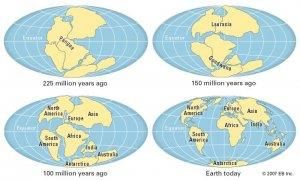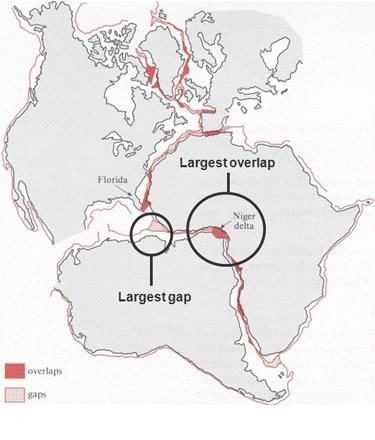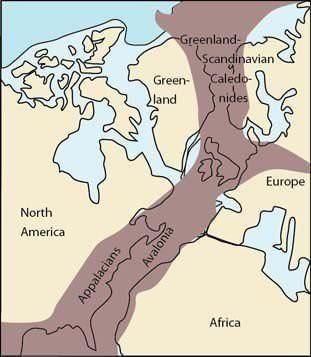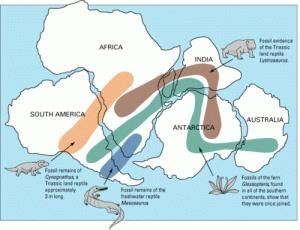Continental Drift Theory | SSC CGL Tier 2 - Study Material, Online Tests, Previous Year PDF Download
Continental Drift Theory (Alfred Wegener)
He postulated that all the earth’s land had once been joined into a single supercontinent surrounded by an ocean. He named this landmass “Pangaea” ( pan = all, Gaea = earth) and the ocean “Panthalassa” (pan = all, Thalassa = ocean). According to the theory, this continental mass started breaking up about 200 million years ago. Since then the pieces had moved to their present positions and are still moving.

Wegener was drawn to this idea because of the puzzling questions he had in his mind.
- How could tropical ferns have grown in London, Paris, Bonn and even in Greenland?
- Why are the coal belts found in extremely cold regions of tundra?
- How are glacial pieces of evidence found in tropical regions of Brazil, Indian peninsula, Australia and Congo basin?
While pondering over these points he came up with two possibilities:
- The climatic zones might have shifted from one region to another while the continents stayed at their places.
- If the climatic zones stayed stationary but the continents changed their places.
As it was difficult for the climatic belts to shift as they are controlled by the position of the sun i.e. tilt of the earth, it appeared more probable that the landmasses were shifted.
The direction of drift:
According to Wegener, the continents drifted in two directions:
- Towards the equator
- Towards the west
Towards the Equator: The reason of the equatorward drift was attributed to the rotation and the equatorial bulge of the earth while the westward movement was due to the gravitation pull of the moon and the sun.
On account of equatorward drift, Africa and Eurasia were pushed closer together and the Tethys sea deposits located in between the two were raised in the form of folded mountains of Alps, atlas, teinshan, Zagros, Hindukush, and the Himalayas. The peninsula of India and Africa was separated from Australia and Antarctica.
Towards the west: On account of the westward drift, North America and South America got separated from Europe and Africa and the Atlantic ocean came into existence.
Evidence in support of the Continental Drift Theory
- “Jigsaw” fit- Wegener was struck by the geographical similarity between the opposite coasts of the Atlantic Ocean. The outlines of the two coasts appear to be the detached portion of the other ie. The east coast of North and South America can be exactly fit into the left coast of Africa and Europe.

- Geological structure- there is a remarkable similarity in geological structure along the two coasts of the Atlantic. The best example is provided by the Appalachian mountains of North America which come right up to the coast and continue their trend across the ocean in the old Hercynian Mountains of southwest Ireland, Wales, and central Europe. The opposite coasts of Africa and Brazil display even greater resemblance in their structure and rocks.

- Permo-carboniferous glaciations- it presents strong proof that at one point in time these landmasses were assembled together since the evidence of this glaciation is found in Brazil, Falkland island, South Africa, the Indian peninsula as well as Australia. It is difficult to explain these extensive glaciations on the basis of the existing distribution of landmass and water. According to Wegener at the time of Pangaea, the South Pole was situated near Durban of the present coast of South Africa.
- Similar Fossil remains of terrestrial animals are found on both coasts of the Atlantic. This cannot be possible if the two landmasses were not joined as it quite impossible for these animals to swim across the Atlantic.
- Paleoclimatic evidence- Coal deposits have been found in temperate and polar regions; however, coal is formed in tropical regions.
- Biological evidence- The lemmings have the tendency to migrate westwards for the search of land, but these creatures have no idea that the land has shifted westwards and the sea awaits for their mass suicide i.e. the migratory pattern of some animal species also hints towards the joined landmass. For example, the entire lemming (a rodent) population crosses North America and falls in the Atlantic. This is estimated that they have not forgotten their route when the landmasses were joined, the might have traveled to Europe and Central Asia.

Criticism of Continental Drift Theory
The continental drift theory was undeniably convincing. But so much of the theory was based on speculation and inadequate evidence. It provoked a lot of criticism and controversy.
The greatest criticism of this theory was due to the controversial forces which were stated to have caused the drift.
- According to experts had the gravitational force of the moon or sun was so strong to cause the landmass to break, then it would have stopped the rotations of the earth and made it stationary.
- Also in order to cause a drift in a landmass, the rotations required should be at such a high speed that it would have thrown the atmosphere (the gases) and everything else in the outer space away from the earth’s gravitational pull.
- Precarboniferous history not known
- Why only northward and westward drift
- Sial floating over Sima – in reality, the lithosphere is floating on aesthenosphere
- The formation of mountains (Rockies and Andes) due to friction by Sima is self-contradictory
- Did not explain the formation of oceanic ridges and Island arcs
|
1365 videos|1312 docs|1010 tests
|
FAQs on Continental Drift Theory - SSC CGL Tier 2 - Study Material, Online Tests, Previous Year
| 1. What is the Continental Drift Theory? |  |
| 2. How does continental drift explain the similarities between fossils found on different continents? |  |
| 3. What evidence supports the Continental Drift Theory? |  |
| 4. Can you explain the process of seafloor spreading and its relationship to continental drift? |  |
| 5. How has the Continental Drift Theory influenced our understanding of Earth's geology and natural processes? |  |
|
1365 videos|1312 docs|1010 tests
|

|
Explore Courses for SSC CGL exam
|

|


















